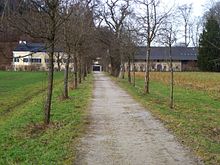Montfort Castle (Salzburg)
The Montfort Castle is in the district of Hellbrunn of Salzburg (Montforterweg 10). Other names for the building are Golserhof or Monforterhof .
history
Already in 1334 an estate near Gols (Gols dua Praedia) is mentioned in the Nonnberger Urbar . In 1382 the property is called "hueb ze gols". In 1412 this hat is in the possession of the noble family of the "Golser", who received it from the Nonnberg monastery as a personal item; it remained in their possession until 1528. Then the property went to Lienhart Hörmann, the son-in-law of Erentraud Golser. The Golser Hof passed from his descendants to Baltasar Egger in 1606. In 1650 Mathias Mayr von Pürglau and his wife Susanne Fabrizin acquired the farm from Magdalena Eggerin, wife of Johann Helbmreicher.
In 1509, next to the Golser Hof, the Lüftenegg castle is mentioned, which was to become a main component of the later Montforter Hof. The sister of Archbishop Johann Ernst Graf Thun Maria Anna, a Countess of Montfort, b. Thun and Hohenstein, acquired the Golserhof in 1699 and, ten years later, Lüftenegg Castle and other surrounding grounds. The property that came about in this way was named after the name of the owner Thunegg Castle or Tumeggerhof. Anton III Count von Montfort (* 1670) had transferred parts of the government business to his son Ernst in 1727 - not least because of a major counterfeiting scandal - and in 1728 moved with his wife Maria Anna Countess von Montfort from the Montfort lordship in the Lake Constance region to Salzburg in the Montforter Hof, both died here in 1733. The Countess of Montfort had bequeathed the property to the family of her grandson Count Josef Lodron as entails in 1733 . If this does not have any male descendants, it should come to the closest related Lodron or Montfort descendants. In 1746, Anton Graf von Montfort († 1787 last of his name), who succeeded Count Josef von Lodron, followed. In 1791 Hieronymus Graf von Lodron bought the farm.
In 1791 he sold the castle to Prince Archbishop Colloredo , who had the manorial power of the Nonnberg monastery repaid and used the farm for hunting trips. The princely hunting ground included the Morzger hill Hellbrunn and the adjacent oak forest. In order to guarantee the hunting guests a successful hunt, there were numerous hunting facilities (small wild fields and salt meadows interspersed in the forest) on and around the Morzger Hügel. Colloredo also had a Gloriette built on the Hinterer Golserberg , from which the Prince Archbishop could enjoy a wonderful view of the Hohensalzburg Fortress and the old town. The building stood on an approximately two meter high base with a square floor plan with a side length of 2 meters. The top of the lantern was 12 m high. The massive castle on the ground floor had a floor plan of 9 × 9 m. The wooden observation tower was 5 m above the building foot.
After Salzburg was annexed to the Habsburg monarchy in 1816, the estate became the Aryan property of the k. and k. Monarchy and was left to the respective district chief (which corresponds roughly to today's governor) to use. The district chiefs Count Welsperg, Count Montecuccoli, Count Stolberg and Count Chorinsky lived in or leased the castle one after the other. In 1875, Montfort Castle came into the possession of Karl Überreiter.
Finally, in 1884, Count Alois von Arco-Stepperg bought the Montforterhof and its surroundings. In 1893 his only daughter, Sophie Countess Moy de Sons, inherited the property. Just like the moated castle Anif and the Villa Swoboda in the Keltenallee (currently the residence of Karl Habsburg-Lothringen), the Montforter Hof was inherited by the Countess' nephew, the art historian Johannes Graf von Moy, who was succeeded by his adoptive son Johannes Graf von Moy as owner. His descendants stuck to the castle, but rented it out. a. to Friedrich Karl Flick . In 2003 it was acquired by his nephew Gert-Rudolf Flick .
description
The lock is a hook-shaped construction. The two wings erected at right angles to each other have uniform plastered window frames on the upper floor. The eastern part of the castle dates from the 15th century, the west wing from the 18th century. Around 1790 it was given its current facade as a hunting lodge .
A farm wing with a stable building has long been part of the castle. Friedrich Graf Spaur praises the progressiveness of the agricultural building (water supply for the cattle, feeding system, light) at the time of Prince Archbishop Colloredo. The old stable has columns arranged in rows in six fields one behind the other , over which a square vault with belt arches is built. Before 1995, there was a carpentry shop in the old stable building. A private vehicle museum should then be set up here, but this has not yet materialized. The eastern wooden part from the period after 1800, once separated from the stable by a path, was later joined with the stable to form a closed building with a uniform roof.
In the past, Montfort Castle was surrounded by a 150 × 50 meter baroque garden . In the decades before 1900, this complex and the surrounding landscape garden were gradually dismantled. The building was completely renovated in 2006 .
literature
- Reinhard Medicus: The two Morzger hills, part 1. The two Morzger hills, part 2. Bastei, magazine of the Salzburg City Association, episode 3 from 2009 and episode 1 from 2010, Salzburg 2009 and 2010 . The Morzger Hills (PDF file; 2.0 MB)
Web links
- Montfort Castle on burgdaten.de
- Montfort Castle in the Salzburgwiki
- Montfort Castle on visit-salzburg.net
Coordinates: 47 ° 45 ′ 58.7 " N , 13 ° 3 ′ 16.7" E


